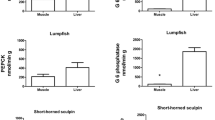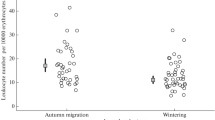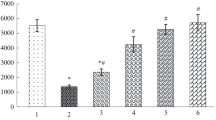Summary
-
1.
Resting blood metabolite concentrations were determined at 19 different times of the daily cycle (15°C, LD12:12). Blood glucose values for 151 frogs determined over a 6-month period yielded a mean level of 24.5±3.0 mg·100 ml−1 blood (mg%). Blood lactate values for 132 animals yielded a mean level of 31.0±12.3 mg%.
-
2.
Blood glucose concentrations over a 24-hour period showed no diel cycle. Blood lactate values over a 24-hour period were much more erratic, but with a distinct peak one h after the onset of scotophase (1900 hrs CST), suggestive of a diurnal cycle.
-
3.
No correlations were found between normal blood glucose and lactate concentrations and weight, sex, or season.
-
4.
Faradic stimulation of 15- and 30 min duration were equally efficient in eliciting maximal lactate concentrations. A 2-min period of shocking was significantly less effective.
-
5.
Stressed (i.e., due to strenuous exercise) blood metabolite concentrations forR. pipiens were determined 0.0, 0.5, 1.0, 2.0, 3.0, 4.0, 5.0, and 8.5 hrs following a 30-min period of Faradic stimulation from 1200 to 1230 hrs CST. Blood glucose levels increased from 20.9 to 57.2 mg% and blood lactate values increased from 18.6 to 99.5 mg% during a period of two hrs following stimulation; normal levels were again attained 4.0 hrs after the end of stimulation.
-
6.
Resting liver, muscle, and total body lactate concentrations were 20.9±3.5, 76.8±17.5, and 44.7±12.5 mg 100 g−1 tissue wt. (mg%), respectively. Stressed tissue lactate levels were determined 0.0, 1.0, 3.0, 4.0, and 7.5 hrs following the Faradic stimulation period. Immediately following the end of stimulation, liver, muscle, and total body lactate concentrations increased by factors of 4.6 (from 20.9 to 95.6 mg%), 3.2 (from 76.8 to 244.0 mg%), and 4.0 (from 44.7 to 180.8 mg%), respectively. After one h of recovery, all three lactate concentrations were reduced abruptly to approximately one-half the peak value and were maintained for several hrs before return to normal values after 7.5 hrs.
Similar content being viewed by others
References
Barlow, O. W., Vigor, W. N., Peck, R. I.: The action of insulin on the frog, the influence of dosage, temperature, excision of the liver, administration of glucose, sodium bicarbonate, and calcium gluconate on the reaction of the frog to insulin. J. Pharm. exp. Therap.41, 229–243 (1931)
Bennett, A. F., Licht, P.: Anaerobic metabolism during activity in lizards. J. comp. Physiol.81, 277–288 (1972)
Bennett, A. F., Licht, P.: Relative contributions of anaerobic and aerobic energy production during activity in amphibia. J. comp. Physiol.87, 351–360 (1973)
Bennett, A. F., Licht, P.: Anaerobic metabolism during activity in amphibians. Comp. Biochem. Physiol.48A, 319–327 (1974)
Black, E. C., Robertson, A. C., Parker, R. R.: Some aspects of carbohydrate metabolism in fish. In: Comperative physiology of carbohydrate metabolism in heterothermic animals (Martin, A. W., ed.), p. 89–214. Seattle: Univ. of Washington Press 1961
Christiansen, J., Penney, D.: Anaerobic glycolysis and lactic acid accumulation in cold submergedRana pipiens. J. comp. Physiol.87, 237–245 (1973)
Duncan, D. B.: Multiple range and multiple F-tests. Biometrisc11, 1–6 (1955)
Fromm, P. O., Johnson, R. E.: The respiratory metabolism of frogs as related to season. J. cell. comp. Physiol.45, 343–360 (1955)
Guimond, R. W., Hutchison, V. H.: The effect of temperature and photoperiod on gas exchange in the leopard frog,Rana pipiens. Comp. Biochem. Physiol.27, 177–195 (1968)
Harris, J. A.: Seasonal variation in some hematological characteristics ofRana pipiens. Comp. Biochem. Physiol.43A, 975–989 (1972)
Hermansen, B., Jorgensen, C. B.: Blood glucose in male toads (Bufo bufo): Annual variation and hormonal regulation. Gen. comp. Endocr.12, 313–321 (1969)
Hutchison, V. H., Whitford, W. G., Kohl, M.: The effect of photoperiod on daily rhythms of oxygen consumption in the tropical toad,Bufo marinus. Z. vergl. Physiol.75, 367–382 (1971)
Jones, D. R., Mustafa, T.: The lactacid oxygen debt in frogs after one hour's apnoea in air. J. comp. Physiol.85, 15–24 (1973)
Mazzocco, P.: Ocilationes periodicas del metabolismo hidrocarbonado en el sapoBufo arenarum (Hensel). Rev. Soc. argent. Biol.14, 330–334 (1938)
Miller, M. R.: Carbohydrate metabolism in amphibians and reptiles. In: Comparative physiology of carbohydrate metabolism in heterothermic animals (Martin, A. W., ed.), p. 125–144. Seattle: Univ. of Washington Press 1961
Mizell, S.: Seasonal changes in energy reserves in the common frog,Rana pipiens. J. cell. comp. Physiol.66, 251–258 (1965)
Scott, E. L., Kleitman, N.: Sugar in the blood of the common frog. Amer. J. Physiol.55, 355–361 (1921)
Seiden, G.: The response of the pancreatic islands of the frogRana pipiens to alloxan. Anat. Rec.91, 187–197 (1945)
Seymour, R. S.: Physiological correlates of forced activity and burrowing in the spadefoot toad,Scaphiopus hammondii. Copeia1, 1–22 (1973)
Smith, C. L.: Seasonal changes in blood sugar, body fat, liver glycogen, and gonads in the common frog,Rana temporaria. J. exp. Biol.26, 412–429 (1950)
Tenney, S. M., Tenney, J. B.: Quantitative morphology of cold-blooded lungs: Amphibia and reptilia. Resp. Physiol.9, 197–215 (1970)
Turney, L. D., Hutchison, V. H.: Metabolic scope, oxygen debt, and diurnal oxygen consumption cycle of the leopard frog,Rana pipiens. Comp. Biochem. Physiol.49A, 583–601 (1974)
Ultsch, G. R.: A theoretical and experimental investigation of the relationship between metabolic rate, body size, and oxygen exchange capacity. Resp. Physiol.18, 143–160 (1973)
Whitford, W. G., Hutchison, V. H.: Body size and metabolic rate in salamanders. Physiol. Zool.40, 127–133 (1967)
Wright, P. A.: Blood sugar studies in the bullfrogRana catesbeiana. Endocrinology64, 551–558 (1959)
Wurster, D. H.: Comparative studies on the blood glucose and pancreatic islets of the salamander,Taricha torosa, and a lizard,Eumeces obsoletus. Ph.D. dissertation, Stanford University (1958)
Author information
Authors and Affiliations
Rights and permissions
About this article
Cite this article
Hutchison, V.H., Turney, L.D. Glucose and lactate concentrations during activity in the leopard frog,Rana pipiens . J Comp Physiol B 99, 287–295 (1975). https://doi.org/10.1007/BF00710369
Received:
Issue Date:
DOI: https://doi.org/10.1007/BF00710369




